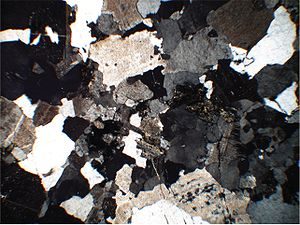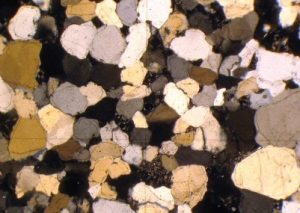5.1 Clastic Sedimentary Rocks
A clast is a fragment of rock or mineral, ranging in size from less than a micron[1] (too small to see) to as big as an apartment block. The smaller ones tend to be composed of a single mineral crystal, and the larger ones are typically composed of pieces of rock. As we’ve seen, most sand-sized clasts are made of quartz because quartz is more resistant to weathering than any other common mineral. Many of the clasts that are smaller than sand size (less than 1/16 or 0.063 mm) are made of clay minerals. Most clasts larger than sand size (greater than 2 mm) are actual fragments of rock, and commonly these might be fine-grained rock like basalt or andesite, or if they are bigger, coarse-grained rock like granite or gneiss. Sedimentary rocks that are made up of clasts are called clastic sedimentary rocks. A comparable term is “detrital sedimentary rocks”.
Grain-Size Classification
Geologists that study sediments and sedimentary rocks use the Udden-Wentworth grain-size scale for describing the sizes of the grains in these materials (Table 5.1). There are six main grain-size categories; five are broken down into subcategories, with clay being the exception. The diameter limits for each successive subcategory are twice as large as the one beneath it. In general, a boulder is bigger than a toaster and difficult to lift. There is no upper limit to the size of boulder.[2] Sand ranges from 2 millimetres down to 0.063 millimetres, and its key characteristic is that it feels “sandy” or gritty between your fingers—even the finest sand grains feel that way. Silt is essentially too small for individual grains to be visible, and while sand feels sandy to your fingers, silt feels smooth to your fingers but gritty in your mouth. Clay is so fine that it feels smooth even in your mouth.
| Type | Description | Size range (millimetres, mm) | Size range (microns, μm) |
|---|---|---|---|
| Boulder | large | 1024 and up | |
| medium | 512 to 1024 | ||
| small | 256 to 512 | ||
| Cobble | large | 128 to 256 | |
| small | 64 to 128 | ||
| Pebble (Granule) | very coarse | 32 to 64 | |
| coarse | 16 to 32 | ||
| medium | 8 to 16 | ||
| fine | 4 to 8 | ||
| very fine | 2 to 4 | ||
| Sand | very coarse | 1 to 2 | 1000 to 2000 |
| coarse | 0.5 to 1 | 500 to 1000 | |
| medium | 0.25 to 0.5 (1/4 to 1/2 mm) | 250 to 500 | |
| fine | 0.125 to 0.25 (1/8 to 1/4 mm) | 125 to 250 | |
| very fine | 0.063 to 0.125 (1/16 to 1/8 mm) | 63 to 125 | |
| Silt | very coarse | 32 to 63 | |
| course | 16 to 32 | ||
| medium | 8 to 16 | ||
| fine | 4 to 8 | ||
| very fine | 2 to 4 | ||
| Clay | clay | 0 to 2 |
If you drop a granule into a glass of water, it will sink quickly to the bottom (less than half a second). If you drop a grain of sand into the same glass, it will sink more slowly (a second or two depending on the size). A grain of silt will take several seconds to get to the bottom, and a particle of fine clay may never get there. The rate of settling is determined by the balance between gravity and friction, as shown in Figure 5.1.1. Large particles settle quickly because the gravitational force (which is proportional to the mass, and therefore to the volume of the particle) is much greater than the frictional resistance (which is proportional to the surface area of the particle). For smaller particles the difference between gravitational push and frictional resistance is less, so they settle slowly.
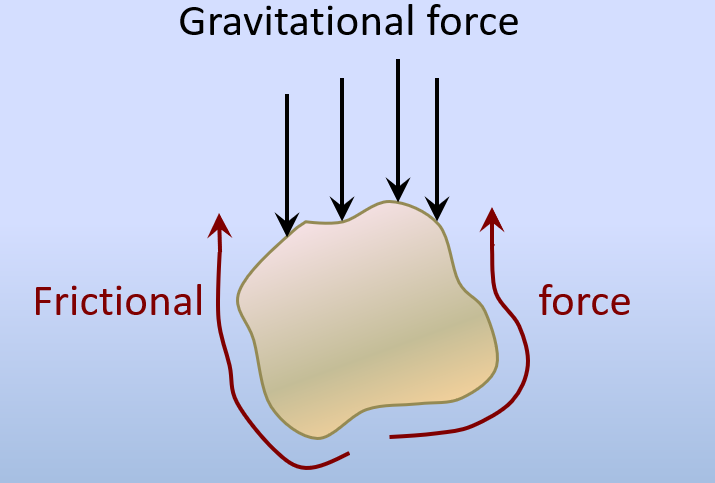
Small particles that settle slowly spend longer suspended in the water, and therefore tend to get moved farther than large particles if the water is moving.
Transportation
One of the key principles of sedimentary geology is that the ability of a moving medium (air, ice, or water) to move sedimentary particles—and keep them moving—is dependent on the velocity of flow. The faster the medium flows, and therefore the higher the energy of the flow, the larger the particles it can move. This is illustrated in Figure 5.1.2. Parts of the river are moving faster than other parts, especially where the slope is greatest and the channel is narrow. Not only does the velocity of a river change from place to place, but it changes from season to season. During peak discharge[3] at the location of Figure 5.1.2, the water is high enough to flow over the embankment on the right, and it flows fast enough to move the boulders that cannot be moved during low flows.
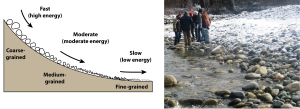
Clasts within streams are moved in several different ways, as illustrated in Figure 5.1.3. Large bed load clasts are pushed (by traction) or bounced along the bottom (by saltation), while smaller clasts are suspended in the water and kept there by the turbulence of the flow. As the flow velocity changes, different-sized clasts may be either incorporated into the flow or deposited on the bottom. At various places along a river, there are always some clasts being deposited, some staying where they are, and some being eroded and transported. This changes over time as the discharge of the river changes in response to changing weather conditions.
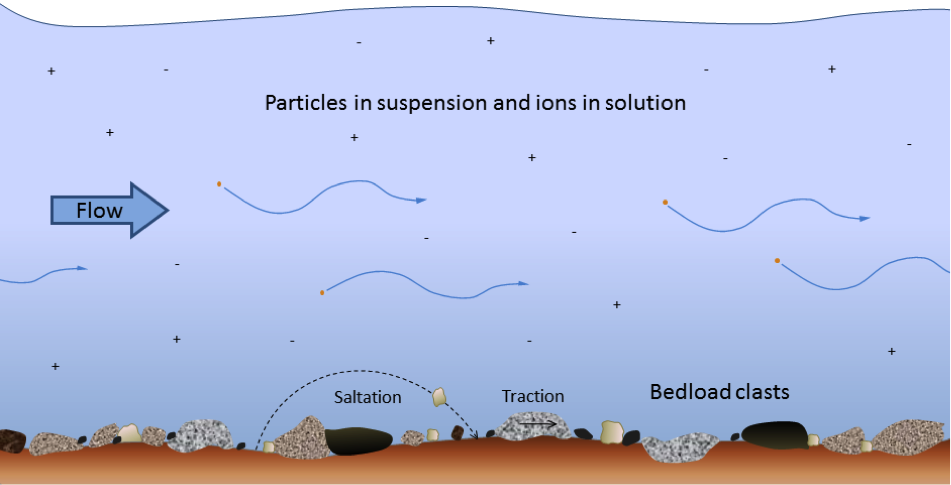
Other sediment transportation media, such as waves, ocean currents, and wind, operate under similar principles, with flow velocity as the key underlying factor that controls transportation and deposition.
Deposition
When the velocity, and the energy level, of the transporting medium (e.g., flowing water in a river, ice in a glacier, wind) decreases and it no longer has sufficient energy to continue transporting sediment, the sediment is deposited. For example, where a river flows into the sea, the velocity of the water decreases abruptly, and the sediment that can no longer be carried is deposited to form a delta. Clastic sediments are deposited in a wide range of environments, including glacial environments, talus slopes, alluvial fans, rivers—both fast and slow—lakes, deltas, and ocean environments—both shallow and deep. If the sedimentary deposits last long enough to be covered with other sediments they may eventually form into rocks ranging from fine shale to coarse conglomerate.
Burial and Lithification
Lithification is the term used to describe a number of different processes that take place within a deposit of sediment to turn it into solid rock (Figure 5.1.4). One of these processes is burial by other sediments, which leads to compaction of the material and removal of some of the intervening water and air. After this stage, the individual clasts are touching one another. Cementation is the process of crystallization of minerals within the pores (void space) between the small clasts, and especially at the points of contact between clasts. Depending on the pressure, temperature, and chemical conditions, this cement might be formed by a range of minerals, the common ones being calcite, hematite, and quartz. You can determine whether a clastic sedimentary rock, like a sandstone, is cemented with calcite by adding a drop of dilute acid to a fresh surface on the sample. If the sample reacts readily with the acid, it is likely cemented by calcite.
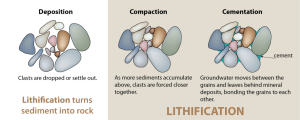
Roundness and Sorting
For any geologist describing sediments and clastic sedimentary rocks, it is not only the size of the clasts that is important for classification, but also the range of sizes and shapes. To describe the shape of clasts in a sedimentary rock, or grains in a unconsolidated sediment, geologists use the term roundness. This scale of roundness from angular to well-rounded is illustrated in Figure 5.1.5. The roundness of a clast tends to reflect the extent to which it has been transported, but keep in mind that the composition of the clast also plays an important role! Grains of phyllosilicate minerals such as biotite or muscovite, for example, will never form rounded grains due to their sheet-like shape. Typically, the longer a clast is in transport, the more it is abraded by other clasts and the more rounded it becomes. Angular clasts, like those common to talus slopes beneath steep mountains, tend to indicate deposition very close to their source, meaning that they have not experienced significant transport.
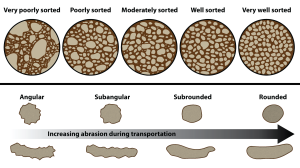
Increased transport also tends to result in well-sorted sediment deposits. Sorting refers to the range of grain sizes in a sediment deposit or in a clastic sedimentary rock (Figure 5.1.5). Poorly sorted sediments contain a wide range of grain sizes. Deposits of glacial till, for example, tend to be very poorly sorted as they contain grain sizes ranging from house-sized boulders to very fine grains of clay. A deposit of fine sand on a beautiful sandy beach, on the other hand, is an example of a well-sorted sediment, as all the grains are sand-sized.
Classification of Clastic Sedimentary Rocks
Clastic sedimentary rocks are classified and named based on both composition and texture. The composition of the grains is particularly important for sandstones, as described below and in Figure 5.1.6. Texture in this case refers to grain size (using the Udden-Wentworth grain-size scale in Table 5.1), roundness, and sorting. The characteristics and distinguishing features of clastic sedimentary rocks are summarized in Table 5.2.
| Group | Examples | Characteristics |
|---|---|---|
| Conglomerate | Dominated by rounded clasts, granule size and larger (>2 mm), poorly to very poorly sorted | |
| Breccia | Dominated by angular clasts, granule size and larger (>2 mm), poorly to very poorly sorted | |
| Sandstone | quartz sandstone | Dominated by sand (1/16 to 2 mm), greater than 90% quartz, range of roundness and sorting possible |
| arkose (feldspathic sandstone) | Dominated by sand (1/16 to 2 mm), greater than 10% feldspar, range of roundness and sorting possible | |
| lithic wacke | Dominated by sand (1/16 to 2 mm), greater than 10% rock fragments, greater than 15% silt and clay, range of roundness and sorting possible | |
| Mudrock | mudstone | Greater than 75% silt (1/256 to 1/16 mm) and clay (<1/256 mm), not bedded, well-sorted, grains too fine to judge roundness using hand lens |
| shale | Greater than 75% silt (1/256 to 1/16 mm) and clay (<1/256 mm), thinly bedded, well-sorted, grains too fine to judge roundness using hand lens |
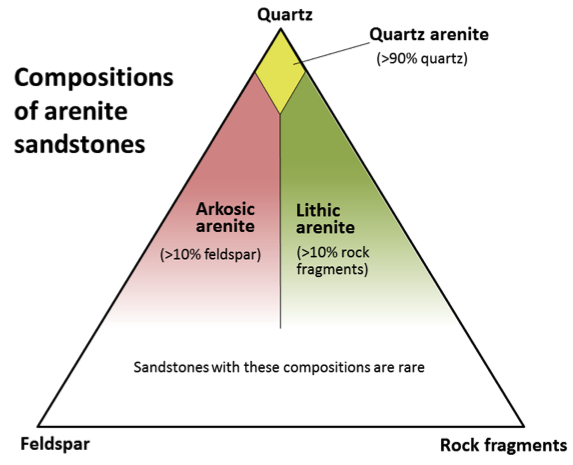
It’s worth taking a closer look at the different types of sandstone because sandstone is a common and important sedimentary rock. Typical sandstone compositions are shown in Figure 5.1.6. Sandstones are mostly made up of sand-sized grains of course, but they also include some finer material—both silt and clay. The term arenite applies to a so-called “clean” sandstone, meaning one with less than 15% silt and clay. Considering the sand-sized grains only (the grains larger than 1/16 or 0.063 mm), arenites with greater than 90% quartz are called quartz arenites. If they have more than 10% feldspar and more feldspar than rock fragments, they are called feldspathic arenites or arkosic arenites (or just arkose). If they have more than 10% rock fragments, and more rock fragments than feldspar, they are lithic arenites.[4] A sandstone with more than 15% silt or clay is called a wacke (pronounced wackie). The terms quartz wacke, lithic wacke, and feldspathic wacke are used with limits similar to those on the arenite diagram. Another name for a lithic wacke is greywacke. Sandstones form in a wide range of environments, including rivers, lakes, beaches, deserts, and shallow oceans.
Some examples of sandstones, magnified in thin section are shown in Figure 5.1.7. (A thin section is rock sliced thin enough so that light can shine through.)

Clastic sedimentary rocks in which a significant proportion of the clasts are larger than 2 mm are known as conglomerate if the clasts are well rounded, and breccia if they are angular. Conglomerates form in high-energy environments such as fast-flowing rivers, where the particles can become rounded. Breccias, characterized by their granule and larger-sized angular clasts, typically form where the particles are not transported a significant distance in water, such as alluvial fans and talus slopes. Some examples of clastic sedimentary rocks are shown on Figure 5.1.8.
Practice Exercise 5.1 Classifying sandstones
Table 5.3 below shows magnified thin sections of three sandstones, along with descriptions of their compositions. Using Table 5.2 and Figure 5.1.6, find an appropriate name for each of these rocks. Using Figure 5.1.5, describe the roundness and sorting in each of the sandstones.
Media Attributions
- Figures 5.1.1, 5.1.2 (right), 5.1.3, 5.1.6, 5.1.7, 5.1.8, Practice Exercise 5.1 bottom two images: © Steven Earle. CC-BY-4.0.
- Figure 5.1.2 (left): © Siobhan McGoldrick. CC-BY-4.0.
- Figure 5.1.4: © Karla Panchuk. CC-BY-4.0.
- Figure 5.1.5: © Siobhan McGoldrick. CC-BY-4.0.
- Practice Exercise 5.1, first image: Aplite Red © Rudolf Pohl. CC BY-SA-3.0.
- A micron is a millionth of a metre. There are 1,000 microns in a millimetre. ↵
- The largest known free-standing rock (i.e., not part of bedrock) is Giant Rock in the Mojave Desert, California. It’s about as big as an apartment building—seven stories high! ↵
- Discharge of a stream is the volume of flow passing a point per unit time. It’s normally measured in cubic metres per second (m3/s). ↵
- “Lithic” means “rock.” Lithic clasts are rock fragments, as opposed to mineral fragments. ↵


